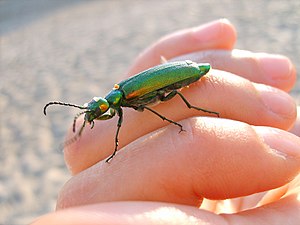
Back الحشرات في الثقافة Arabic Interactions entre humains et insectes French Serangga dalam budaya ID Insetos na sociedade Portuguese Насекомые в культуре Russian Узајамни односи људи и инсеката Serbian Комахи в культурі Ukrainian Côn trùng trong đời sống con người Vietnamese

Human interactions with insects include both a wide variety of uses, whether practical such as for food, textiles, and dyestuffs, or symbolic, as in art, music, and literature, and negative interactions including damage to crops and extensive efforts to control insect pests.
Academically, the interaction of insects and society has been treated in part as cultural entomology, dealing mostly with "advanced" societies, and in part as ethnoentomology, dealing mostly with "primitive" societies, though the distinction is weak and not based on theory. Both academic disciplines explore the parallels, connections and influence of insects on human populations, and vice versa. They are rooted in anthropology and natural history, as well as entomology, the study of insects. Other cultural uses of insects, such as biomimicry, do not necessarily lie within these academic disciplines.
More generally, people make a wide range of uses of insects, both practical and symbolic. On the other hand, attitudes to insects are often negative, and extensive efforts are made to kill them. The widespread use of insecticides has failed to exterminate any insect pest, but has caused resistance to commonly-used chemicals in a thousand insect species.
Practical uses include as food, in medicine, for the valuable textile silk, for dyestuffs such as carmine, in science, where the fruit fly is an important model organism in genetics, and in warfare, where insects were successfully used in the Second World War to spread disease in enemy populations. One insect, the honey bee, provides honey, pollen, royal jelly, propolis and an anti-inflammatory peptide, melittin; its larvae too are eaten in some societies. Medical uses of insects include maggot therapy for wound debridement. Over a thousand protein families have been identified in the saliva of blood-feeding insects; these may provide useful drugs such as anticoagulants, vasodilators, antihistamines and anaesthetics.
Symbolic uses include roles in art, in music (with many songs featuring insects), in film, in literature, in religion, and in mythology. Insect costumes are used in theatrical productions and worn for parties and carnivals.
© MMXXIII Rich X Search. We shall prevail. All rights reserved. Rich X Search